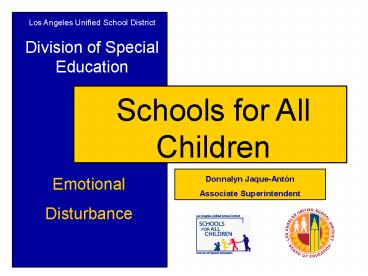Emotional Disturbance - PowerPoint PPT Presentation
1 / 22
Title:
Emotional Disturbance
Description:
Los Angeles Unified School District Division of Special Education Schools for All Children Emotional Disturbance Donnalyn Jaque-Ant n Associate Superintendent – PowerPoint PPT presentation
Number of Views:578
Avg rating:3.0/5.0
Title: Emotional Disturbance
1
Los Angeles Unified School District Division of
Special Education
Schools for All Children
Emotional Disturbance
Donnalyn Jaque-Antón Associate Superintendent
2
Emotional Disturbance
3
Overview
- Definition
- Impact of disability
- Assistance with
- academic tasks
- behaviors
- social skills
- Hierarchy of behavioral supports
- Positive behavior support
- Behavior support plan
- Strategies
4
Definition
- "...a condition exhibiting one or more of the
following characteristics over a long period of
time and to a marked degree that adversely
affects a child's educational performance-- - An inability to learn that cannot be explained by
intellectual, sensory, or health factors. - An inability to build or maintain satisfactory
interpersonal relationships with peers and
teachers.
5
Definition (cont.)
- Inappropriate types of behavior or feelings under
normal circumstances. - A general pervasive mood of
- unhappiness or depression.
- A tendency to develop physical
- symptoms or fears associated with personal or
school problems." - Code of Federal Regulations, Title 34, Section
300.7(c)(4)(i)
6
Emotional Disturbance is NOT
- Social maladjustment
- Behavior in conflict with parent
- Behavior associated with a subculture and
contrary to larger community mores - Behavior which does not render student helpless,
confused or disorientated
7
Emotional Disturbance is NOT
- Conduct disorder
- Aggression against people or animals
- Property destruction
- Lying or theft
- Serious rule violation
8
Impact of Disability
- Academic
- Skill deficits
- Trouble beginning tasks
- Difficulty maintaining attention
- Problems completing tasks
9
Impact Behavior
- Externalizing Acting out
- Aggression
- Defiance
- Disruption
- Fighting
- Internalizing - Withdrawing
- Isolation
- Self abuse
- Depression
- Anxiety
- Interaction with others (making and keeping
friends) - Coping strategies
- Reading social cues
10
Academic Tasks - Assistance
- Provide clear, specific directions
- Use curricular interventions
- Tasks at students academic level
- Assignments broken into smaller parts
- Breaks given as needed
- Student strengths utilized to learn new material
- Opportunities for choice making
11
Externalizing Internalizing Behaviors
Assistance
- Listen to/observe student and make adjustments
- Teach relaxation techniques
- Teach alternate behaviors
12
Social Skills - Assistance
- Teach social skills proactively
- Break skills down into parts
- Teach, model, practice and reinforce skills
- Teach self-regulating skills
13
Hierarchy of Behavioral Supports
- Schoolwide positive behavior support
- Classroom Management
- Individual Support Plan
14
Developed by Institute On Violence and
Destructive Behaviors, University of Oregon (1999)
- Intensive social skills training
- Individual behavior management plans
- Parent training and collaboration
- Multi-agency collaboration (wrap-around) services
Targeted/ Intensive (High-risk
students) Individual Interventions (3-5)
- Intensive social skills training
- Self-management programs
- Parent training and collaboration
- Adult mentors (check-in)
- Increased academic support
Selected (At-risk Students) Classroom Small
Group Strategies (10-15 of students)
- Social Skills Training
- Positive, proactive discipline
- Teaching school behavior expectations
- Active supervision and monitoring
- Positive reinforcement systems
- Firm, fair, and corrective discipline
Universal (All Students) School-wide
Systems of Support (85-90 of students)
15
School-wide Positive Behavior Support
- School-wide rules and expectations
- Defined
- Taught
- Modeled
- Practiced
- Reinforced
- ALL members of school community participate in
development and implementation of policy
16
Classroom Management
- Identify 3 5 clear, concise , positively stated
rules - Taught, modeled, practiced, reinforced
- Reinforce appropriate behavior
- Predictable schedule/environment/routine
- Active monitoring
- Provide corrective feedback privately
- Avoid power struggles between student and staff
17
Individual Behavior Support Plan
- A-B-C
- Antecedent Behavior - Consequence
- Communicative Intent (purpose of the behavior)
- To get or get away from
- Sensory, Escape, Attention, Tangible
- Replacement behavior
- What the should the student do instead?
- Must serve the same purpose
- Reinforcement
- How, when, how often will student be reinforced?
18
Proactive vs. Reactive Strategies
- Proactive
- Teach new behaviors
- Reinforce appropriate behavior
- Emphasize positive expectations
- Reactive
- Does not promote new learning
- May stop the behavior momentarily
- Emphasize negative consequences
19
Examples of Strategies
- Proactive
- Point system rewards
- Modeling
- Clear, specific expectations
- Contracts
- Reactive
- Time away
- Planned ignoring
- Loss of activities, privileges
- Punishment
20
How Can Support Be Provided?
- Unconditional positive regard for the student
- Teach appropriate behavior and social skills
- Positive reinforcement for appropriate behavior
- Prompts (visual, auditory, gesture, picture)
- Frequent positive check in
- with school staff
- Schedules
- Peer support
21
Resources
- Durand, V. Mark. Severe Behavior Problems. New
York Guilford Press, 1990. - House, Samm N. Behavior Intervention Manual.
Columbia, MO Hawthorne Educational Services,
2002. - Janney, Rachel, and Snell, Martha E. Behavioral
Support. Baltimore Brookes Publishing, 2000. - McCarney, Stephen, Wunderlich, Kathy, and Bauer,
Angela. Pre-Refferal Intervention Manual, 2nd
edition. Columbia, MO Hawthorne Educational
Services, 1993. - McGinnis, and Goldstein, Arnold P. Skillstreaming
in the Elementary School Child. Champaign, IL
Research Press. - ONeill, Robert, Horner, Robert, Albin, Richard,
Sprague, Jeffrey, Storye, Keith, and Newton, J.
Stephen. Functional assessment of Program
Development for Problem Behavior, 2nd edition.
New York Brooks/Cole Publishing, 1997. - Wright, Diana Browning, Gurman, Harvey. Positive
Intervention for Serious Behavior Problems.
Sacramento California Department of Education,
2001.
22
Our lives are not determined by what happens to
us but by how we react to what happens, not by
what life brings to us, but by the attitude we
bring to life. A positive attitude causes a chain
reaction of positive thoughts, events and
outcomes. It is a catalyst, a spark that creates
extraordinary results. ?Anonymous































